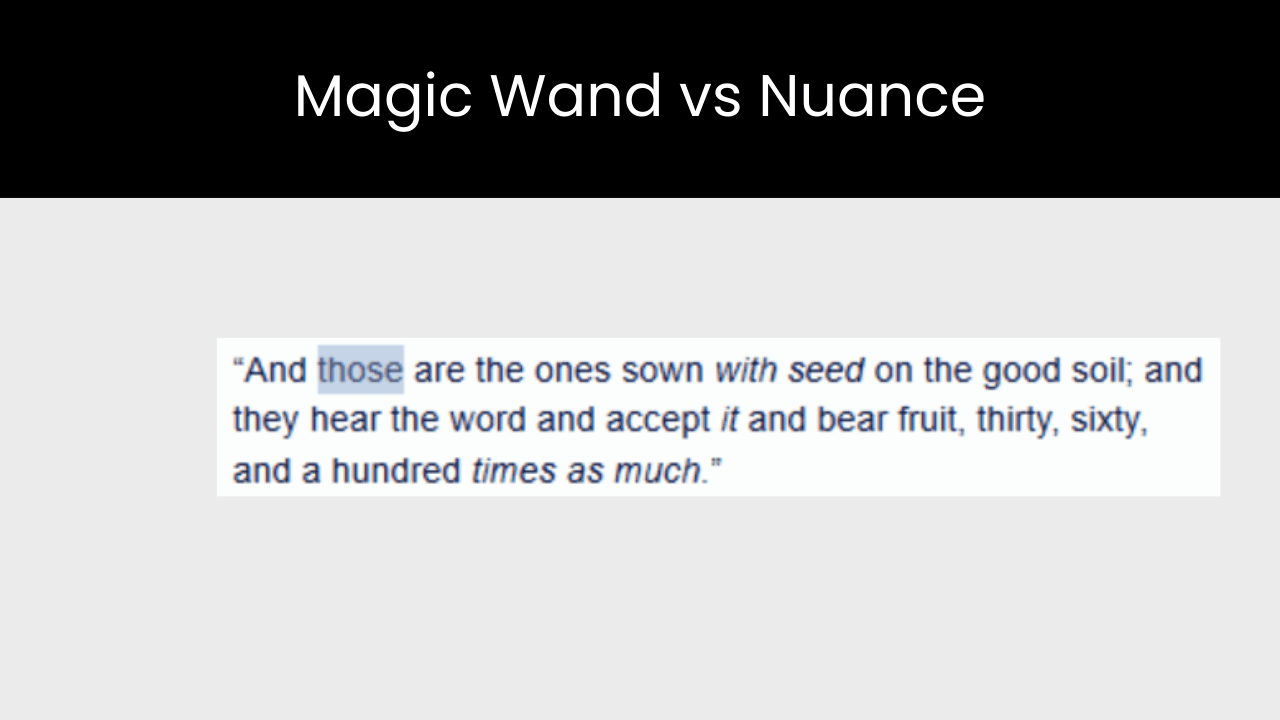The Inside-out Sandwich: An Approach to Studying and Teaching the Bible
Are commentaries cheating? Or do we need commentaries and study helps to understand and teach the scripture? I believe using commentaries and study helps is important. Even more important, though, is keeping our primary attention on scripture itself.
What I call the “inside-out sandwich” is a process for bible study intended to keep our primary attention on scripture, while incorporating genuinely helpful attention to commentaries and study helps. The goal is to engage directly and personally with the text of scripture. Study helps should enhance direct engagement with scripture, not substitute for personal study.
The inside-out out sandwich involves three stages.
- Stage one: Read and study the text without commentaries or other study helps.
- Stage two: Consult study helps.
- Stage three: Prepare final teaching notes directly from the biblical text.
A hamburger is flanked by two pieces of bread. The good stuff is in the middle surrounded by less valuable material. When studying scripture, the sandwich should be inside out. The meat of scripture comes first and last, while the less valuable, but still useful, human commentaries and study helps come in the middle.
The teacher must also study his audience as well as his own life and relationship to God. However, this essay focuses on the study of scripture passages. This simple process applies well to Sunday school lessons, sermons, and other bible teaching.
Stage One: Read and engage the text on your own
The first step is reading the passage without commentaries or study helps. Don’t stop with the first reading. The goal is an overall grasp of the passage, based on your own understanding. Create your own representation of the passage. If you are artistic, you might draw a picture, or sketch a diagram. Of course, jotting notes or making an outline works as well. The point is to put work into your own understanding or mental map of the text. One of my personal favorite methods is to copy and paste the text into a document and then break it into smaller units and rearrange them on the screen. You can see some examples at my website.
It’s tempting to focus on potentially controversial points. That can be a distraction; first, we need to wrestle with the text as a whole and discern the author’s emphasis. What is his overarching purpose in the text? How does he use details to achieve that? The author’s focus is likely different from ours. Once we gain a sense of the whole, we will be better able to think about controversial words or phrases. We are also equipped to read a commentary with discernment.
Observation is hard work. You can find more pointers in this article by Frank Reed. Living by the Book by Howard Hendricks is a modern classic that also offers many helpful suggestions for how to look carefully at a scripture passage. It is available in various editions.
Stage Two: Consult study resources
Anything outside of your bible is a commentary or study resource. Many things between the covers of what are called “study bibles” are also commentary. Study bible notes should be diligently avoided in stage one, but are fine in stage two. When preparing to teach Sunday school in a time crunch, or preparing for Sunday School as a student, the quarterly might be the only study help used. However, over the course of time we want to use a broader variety of study helps than found in either a study bible or a Sunday school book. We don’t want to be limited to the editorial perspective that shapes such books. Commentaries, word studies, bible dictionaries, early Christian writers, and so forth can all be sources of background info and insight. Practice using these resources in print, online, or in specialized bible software, as best fits your personal situation and study process.
What resource you choose is less important than how you use it. Study helps can enlarge or, in some cases correct, your understanding of the passage; they don’t replace your own thinking. Background information on history or culture can expand your perspective. Just don’t check your brains at the door. Historical information may be speculative and, at any rate, often doesn’t have the interpretative implications some think it does. Original language resources can help, but again make sure the proposed “insight” fits with the passage. Crosscheck any extraordinary claims about the meaning of Greek or Hebrew words with several good modern translations.
I will end this section with a case study to illustrate the kinds of insights we might find through commentaries or study resources. Hebrews 12:15-16a reads,
See to it that no one fails to obtain the grace of God; that no ‘root of bitterness’ spring up and causes trouble, and by it many become defiled; that no one is sexually immoral or unholy like Esau,
Let’s hone in on the phrase “root of bitterness.” It is often described as grudges and resentment taking root in our hearts. However, there is one important clue that suggests this is misreading. The whole clause is an allusion to Deuteronomy 29:18. The Greek text closely follows the wording of the Septuagint (the Greek Old Testament).1 (The parallel can be seen in English, but is more striking in Greek.) Deuteronomy describes the “root of bitterness” as a person or group among the Israelites who don’t heed God’s word, but “walk in the stubbornness of their heart” and bring His judgement on the land.
In light of this allusion, and in light of the context in Hebrews, I see this passage as an exhortation to guard each other. We are to warn and encourage our brothers and sisters toward faith and away from any form of unbelief or disobedience that might cause them to be a “poisonous and bitter root” springing up in the church.
Originally, a commentator alerted me to this meaning of the phrase “root of bitterness.” However, I don’t propose this interpretation on the authority of that commentator (whose name I don’t even know). Rather I have compared the text in Deuteronomy with this passage and worked to understand the author’s flow of thought in Hebrews. I should add that I relied on a bible with a good cross reference to find the Old Testament reference. In the same way, you should not just take my word for it, but rather let my comments stimulate your own thoughts and study.
Stage Three: Prepare teaching notes from the text.
When you are ready for your final Sunday school or sermon notes, or the final draft of a paper, work directly from the text. Your focus is now on helping your listener engage with and receive the message of the text for themselves. Depending on the passage and the context in which you are sharing, receiving the message will take different forms; You might want your listeners to be encouraged, inspired to praise God, called to repentance, or simply led to a more mature understanding of life. You want to lead your listeners to encounter God’s message themselves, not just to announce your conclusions about His message.
There is nothing wrong with reading quotes from a commentator or referencing background information from your study. Just situate those quotes within your own study and understanding of the passage. Don’t hesitate to omit things you studied which you either don’t understand or don’t know how to explain to others. Let those puzzles stick in your mind and ‘ponder them in your heart’, but as long as you are confident that you are being faithful to the text, speak from what you do understand and make only passing reference to the puzzles.
I have presented the “inside-out sandwich” as three distinct steps. In real life, these steps get jumbled together, and sometimes one might be skipped. That is fine, but attention to the three stages can help embed some important principles into your study of scripture.
- Wrestle personally and directly with the inspired text of scripture and discern what the scripture emphasizes.
- Consult other people through commentaries or study in order to enlarge or correct your understanding.
- Speak from your personal engagement with the text, aiming to help your audience come to grips with its message.
1The Septuagint (LXX) was a Greek translation of the Hebrew Old Testament widely used in New Testament times.For more information on the Septuagint see this interview with David Bercot https://anabaptistperspectives.org/septuagint, or a briefer discussion in this essay by Vince Beiler https://anabaptistperspectives.org/hebrew-bible-history-part-2. Verse numbering in the Septuagint sometimes differs from our English Bibles. The Septuagint reference is Deuteronomy 29:17. Return to context⬏










Leave a Reply